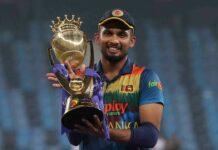Two days ago, Sri Lankan cricketer Tillakaratne Dilshan turned 38. There’s not much time left for Dilshan to hang up his boots. But he is fiercely motivated. He wants to see Sri Lanka win the World Cup, having failed in the last two attempts at the final hurdle.
The Sri Lankans have remarkably raised their games in ICC events. Dilshan’s performances are often overshadowed by those of Mahela Jayawardene and Kumar Sangakkara. The opener, however, has been more consistent in ICC events than the other two stars. His World Cup average of 47 is significantly higher than his career average of 37.
And like Sangakkara and Jayawardene, Dilshan too will be hugely missed although people haven’t fully realised it. On the cricket field, there’s no role that he couldn’t perform. He did all what was asked of him and the establishment on more than one occasion let him down badly.
In 2009, when the balance of the side was selectors’ concern, they requested Dilshan to accomplish a tough task. Pakistan were touring the island and Dilshan was asked to keep wickets in the three-match Test series. He obliged reluctantly, but did a splendid job.
Then for the next series, the selectors went a step further. With the team struggling to find a reliable opener in Test cricket, Dilshan was asked to open as he had had some success in the shorter versions of the game in the same role. It looked a massive gamble. Dilshan had just reestablished himself in the side after being in and out of the team. But here is a man who never shied away from a challenge.
In the first game he opened batting, he came up with scores of 92 and 123 not out. Since then he opened batting for the side until he retired from Tests early this year.
Doubters kept asking questions. It was said that his faulty technique will be exposed when Sri Lanka travel overseas. The tour of England in 2011 dispelled those doubts. Sri Lanka suffered an innings defeat in the first Test in Cardiff. They were blown away for 82 in the second innings and questions were asked about the openers’ ability to see off the new ball.
Dilshan silenced the critics with a remarkable effort in the next Test at Lord’s. He hammered a career best 193 and broke Sidath Wettimuny’s 27-year-old record for the highest score by a Sri Lankan at Lord’s.
No task has been too difficult for generous Dilshan. With the 2011 World Cup being played in the subcontinent, he was told to spend more hours practicing his offspin as it could come handy in the tournament. It certainly did. Dilshan claimed eight wickets during the tournament at an average of 15. The team’s other leading bowlers – Muttiah Muralitharan, Lasith Malinga and Ajantha Mendis averaged more.
At the age of 38, Dilshan remains the fittest in the team and surprisingly Sri Lanka’s best fielder in the last ten years. He keeps striving for perfection.
Two days after the 2011 World Cup, Sangakkara stepped down from captaincy to the surprise of his own team-mates. Sangakkara had been in the job for less than two years and at the age of 33 had lot of cricket left in him.
Jayawardene didn’t want the captaincy either. He stepped down as vice-captain. A few hours later, the selection panel headed by Aravinda de Silva stepped down. Sri Lankan cricket was in a crisis.
Duleep Mendis was brought in as chairman of selectors. There were no choices for captaincy. Dilshan was the Hobson’s choice. Mendis, a tough disciplinarian, summoned Dilshan for a meeting. The flashy star was offered the captaincy. Mendis, however, insisted that Dilshan should behave like a national captain and change his appearance. That he did. The hair was trimmed, the goatee was gone and the stud was removed. Dilshan took up the job that no one wanted.
Sangakkara never gave a proper explanation as to why he quit captaincy. But he is a sharp man. Muralitharan was gone after the 2011 World Cup and that year, Sri Lanka had four tough series – England, Pakistan and South Africa away from home and Australia at home. Perhaps Sangakkara wanted to leave captaincy with an unblemished record.
Dilshan struggled as captain. Malinga’s sudden announcement that he would quit Test cricket a few days after Dilshan was installed as captain came as a bitter blow. With Murali retired, Dilshan was looking up to Malinga to play a key role during his tenure. Sri Lanka lost all four Test series in 2011 under Dilshan. There was talk of not much support from the senior players during his tenure. Under Dilshan, Sri Lanka played nine Tests away from home and one senior went through the nine Tests without making a single half-century.
Around November 2011, the administration was having discussions with seniors to take over the captaincy. One senior agreed. But he had a condition. He would take up captaincy only after Sri Lanka’s tour of South Africa later that year. South Africa obviously is one of the toughest tours. Surprisingly, the administration agreed for the condition and sold Dilshan down the river.
Sri Lanka didn’t do too badly in South Africa although they lost both Test and ODI series. On that tour, they recorded their maiden Test win on South African soil. They also won two of the five ODIs. Previous Sri Lankan tours to South Africa had been catastrophic.
On the last day of the tour, Dilshan was asked about the media reports that suggested that he will be removed as captain. He replied that he wasn’t bothered about rumours. He said that he wanted to move forward as some young players had emerged during his tenure and believed he had the full support of the administration. The future looked bright he added. Yet, less than 24 hours later, he announced that he was stepping down from captaincy. His bosses at the establishment had a deal. Dilshan was only serving time.























